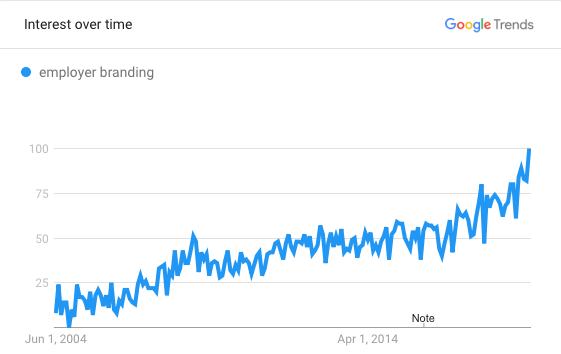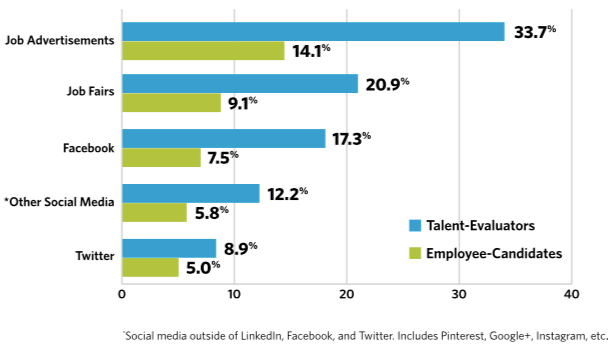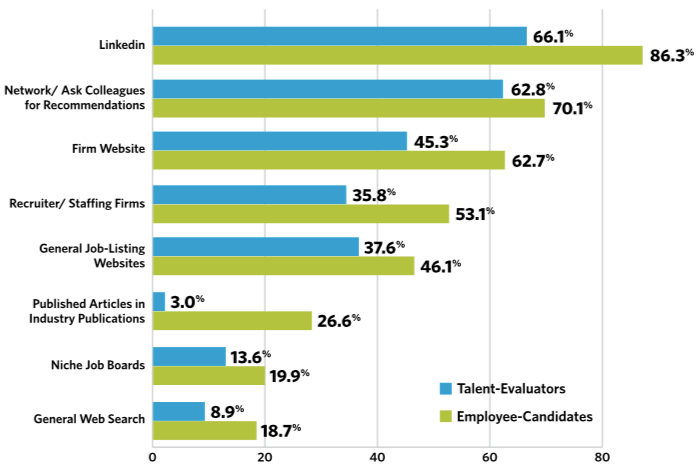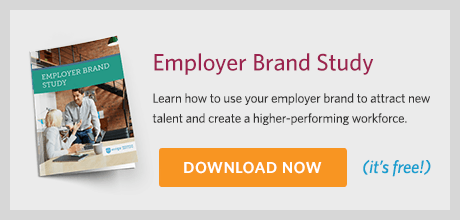Since its introduction in 1990, employer branding has become an important marketing tool at businesses that rely on attracting high-quality people to maintain their competitive edge. And its influence has been growing over time. According to Google Trends, interest in employer branding has reached an all-time high this year (see Figure 1 below).
Figure 1. Google Trends report for the term “employer branding.”

Very likely, much of this recent attention is driven by a highly competitive jobs market — and it is especially relevant to the professional services, where talent acquisition has been a perennial challenge and is only getting tougher as the pool of available labor gets smaller.
Download The Employer Brand Study
Whether your firm already has a formal employer branding program or you are considering starting one for the first time, you want to be sure you are investing your marketing dollars in the most effective techniques. But that begs a question: how do you know what works?
What the Research Tells Us
In our 2017 study of over 800 employee candidates and talent evaluators, we set out to find answers. What we discovered was that many employers are investing in marketing channels that don’t produce great results. In fact, a third of firms have failed to recognize the one channel used by more than 86% of job seekers.
Figure 2 shows the five employer marketing tactics in our research that are more popular with employers than with the job seekers they are trying to reach. In other words, firms are spending a lot of money in places prospective employees rarely look. This includes placing traditional job advertisements and participating in job fairs — two old-school techniques, perhaps, whose time has passed (but more on this in a moment).
Figure 2. Marketing channels that are overutilized by employers.

Even Facebook, the digital home to over a billion people, underperforms. Apparently, when it comes to finding their next job, professionals don’t think of Facebook as a serious resource. Twitter, Instagram and other second-tier social media brands also fail to captivate professional services job seekers.
So what are your better options? Where should you be investing your employer branding dollars? Additional data, shown in Figure 3, provide a path forward.
Figure 3. Marketing channels that are underutilized by employers.

The most important takeaway from this chart is that LinkedIn is the single most important marketing channel for recruiting, relied on even more often than networking and personal recommendations. LinkedIn is used by 86% of job seekers, but only 66% of firms are actively looking at LinkedIn for job candidates, a 20 percentage point gap. Clearly, LinkedIn has not only become the networking platform of choice, it’s where job candidates go first when they are ready to find a new position.
Another insight that firms would be wise to heed is the importance of their website as a recruiting tool. A third of job candidates were likely to use firm websites during their job search (frankly, we thought this number would be even higher). But fewer than half of firms actively use their website to attract employees — another large gap.
We can also see that job seekers use staffing firms, job-listing websites and specialized job boards more often than hiring firms do.
The largest gap of all can be seen in the role that published articles play in the recruiting process. According to our study, three quarters of job seekers are looking for a firm that has a good reputation in the marketplace. So it is not surprising that a significant percentage (26%) see published articles as an indicator of market leadership. The vast majority of firms, however, aren’t thinking about their thought leadership as an asset in their employer brand.
A Generational Perspective
Market research is rarely neat and tidy. Often, one set of data appears to contradict another set in the same study — until you unravel it. Our research was no different.
When we looked at the appeal of different channels to different age groups, we found many similarities, but also some stark differences. One of the most surprising differences are job fairs, which I suggested earlier may be of declining relevance. But when we teased apart the data by generation, we were surprised at first to find that Millennials, the youngest cohort in our study, were 4-5 times more likely to attend job fairs than their Gen-X and Baby Boomer peers (see Figure 4.)
Figure 4. Generational differences in marketing channel preference.

We soon theorized, however, that job fairs are probably more suited to candidates earlier in their careers. Most executive-level positions, for instance, are being filled through different channels.
So, are job fairs still a viable recruiting channel? The answer may very well depend on the level of person you are hiring. That said, the numbers don’t support putting a great deal of resources into this technique.
Download The Employer Brand Study
The other results in this data set are not all that surprising: Millennials are more comfortable using digital platforms, including online job listing sites and web-based search.
What This Means for Your Employer Brand
What implications do these research findings have on your employer brand? Here are a few suggestions:
- Don’t underestimate the power of LinkedIn. Job seekers are using LinkedIn more than any other platform to find job opportunities and research firms.
- Consider engaging a professional recruiter to leverage LinkedIn. Many recruiters today are using LinkedIn to contact promising candidates, whether or not they are actively looking for a new position — and with great success.
- Create an appealing employer brand on your website. Devote a page — or even better, several pages — to describe your workplace, culture and benefits. The more you use photos, employee testimonials and specific examples of why working at your firm is a better experience, the more persuasive your brand will be. And don’t forget to talk about the important work you do, your firm’s awards and other factors that demonstrate your leadership and importance to the industry.
- Don’t think of Facebook as your recruiting homepage. Facebook is a perfectly appropriate place to post staff photos and fun memes, but it’s not where job hunters are going first to look for job openings or to learn about your firm.
- Spread the word. When you have a job opening, let people in your network know. Job seekers are asking their friends and colleagues to learn about opportunities.
- Post on niche and general online job sites. Today’s candidates are looking online for job opportunities. Traditional print ads, not so much.
- Become thought leaders. This is at least as important to your client-facing brand as your employer brand. Either way, Visible Expertise is a major win.
If you’ve been building or maintaining an employer brand — or if you are just looking for new ideas to attract the talent you need — these insights should make better use of your limited time and budget. Feel free to share your employer branding challenges and ideas in the comments section below.
Additional Resources:
- Our Rebranding Guide gives you the tools and knowledge you need to lead your firm through a rebranding.
- Get strategies, tips, and tools for developing your firm’s brand with Hinge’s Brand Building Guide for Professional Services Firms.
- Join Hinge University and take the in-depth courses and read the step-by-step How-Tos to take your brand to a new level of sophistication and engagement.
How Hinge Can Help:
Hinge’s Branding Program equips your firm to stand out in a crowded marketplace and build a distinguished brand that drives sustained growth. From strategy to implementation, we take your firm through the rebranding process — painlessly and with exceptional results.


